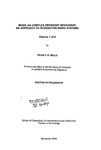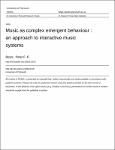Music as complex emergent behaviour : an approach to interactive music systems
| dc.contributor.author | Beyls, Peter F. E. | |
| dc.contributor.other | Faculty of Arts | |
| dc.contributor.other | Faculty of Science and Engineering | en_US |
| dc.date.accessioned | 2011-10-11T11:14:49Z | |
| dc.date.accessioned | 2011-09-28T11:27:37Z | |
| dc.date.available | 2011-10-11T11:14:49Z | |
| dc.date.available | 2011-09-28T11:27:37Z | |
| dc.date.issued | 2009 | |
| dc.date.issued | 2009 | |
| dc.identifier | Not available | en_US |
| dc.identifier.uri | http://hdl.handle.net/10026.1/872 | |
| dc.description | Access to the full-text thesis is no longer available at the author's request, due to 3rd party copyright restrictions. Access removed on 28.11.2016 by CS (TIS). | |
| dc.description | Metadata merged with duplicate record (http://hdl.handle.net/10026.1/770) on 20.12.2016 by CS (TIS). | |
| dc.description | This is a digitised version of a thesis that was deposited in the University Library. If you are the author please contact PEARL Admin (pearladmin@plymouth.ac.uk) to discuss options. | |
| dc.description.abstract |
This thesis suggests a new model of human-machine interaction in the domain of non-idiomatic musical improvisation. Musical results are viewed as emergent phenomena issuing from complex internal systems behaviour in relation to input from a single human performer. We investigate the prospect of rewarding interaction whereby a system modifies itself in coherent though non-trivial ways as a result of exposure to a human interactor. In addition, we explore whether such interactions can be sustained over extended time spans. These objectives translate into four criteria for evaluation; maximisation of human influence, blending of human and machine influence in the creation of machine responses, the maintenance of independent machine motivations in order to support machine autonomy and finally, a combination of global emergent behaviour and variable behaviour in the long run. Our implementation is heavily inspired by ideas and engineering approaches from the discipline of Artificial Life. However, we also address a collection of representative existing systems from the field of interactive composing, some of which are implemented using techniques of conventional Artificial Intelligence. All systems serve as a contextual background and comparative framework helping the assessment of the work reported here. This thesis advocates a networked model incorporating functionality for listening, playing and the synthesis of machine motivations. The latter incorporate dynamic relationships instructing the machine to either integrate with a musical context suggested by the human performer or, in contrast, perform as an individual musical character irrespective of context. Techniques of evolutionary computing are used to optimise system components over time. Evolution proceeds based on an implicit fitness measure; the melodic distance between consecutive musical statements made by human and machine in relation to the currently prevailing machine motivation. A substantial number of systematic experiments reveal complex emergent behaviour inside and between the various systems modules. Music scores document how global systems behaviour is rendered into actual musical output. The concluding chapter offers evidence of how the research criteria were accomplished and proposes recommendations for future research. | en_US |
| dc.language.iso | en | en_US |
| dc.publisher | University of Plymouth | en_US |
| dc.title | Music as complex emergent behaviour : an approach to interactive music systems | en_US |
| dc.type | Thesis | |
| dc.identifier.doi | http://dx.doi.org/10.24382/4218 |
Files in this item
This item appears in the following Collection(s)
-
01 Research Theses Main Collection
Research Theses Main



